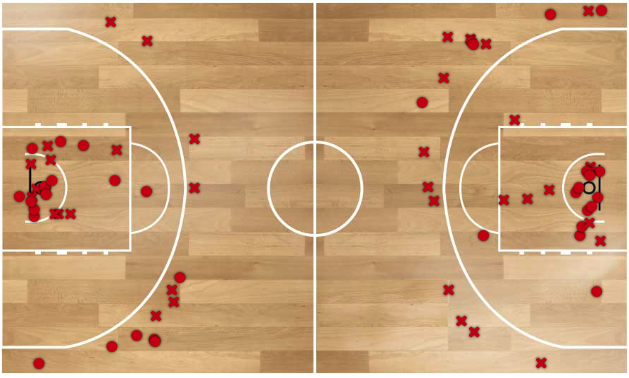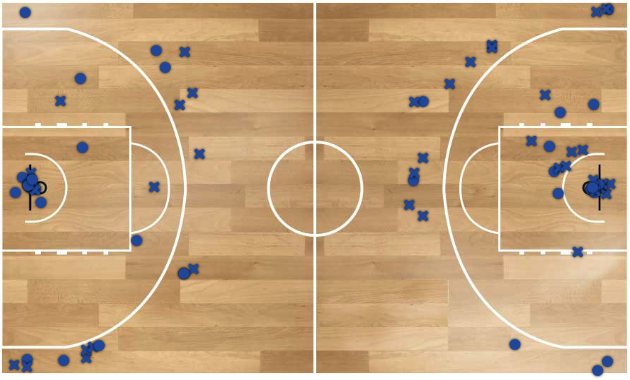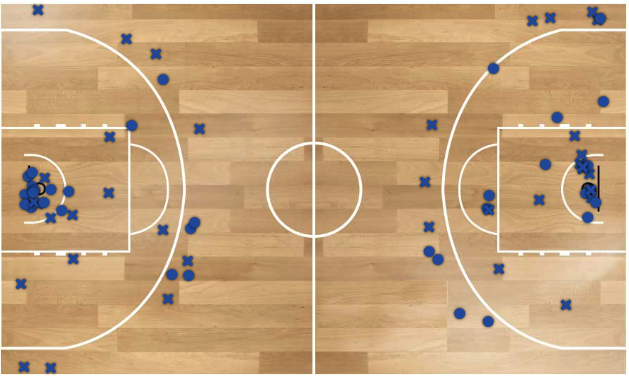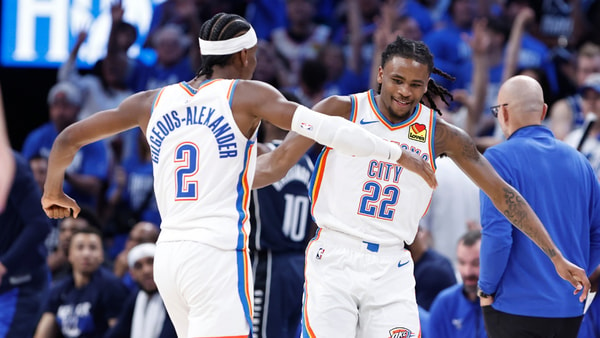Three questions and three answers for Kentucky leaving GLOBL JAM

Kentucky did its job in Toronto, winning four straight games en route to a gold medal in the 2023 GLOBL JAM, clearly the most dominant team in the international showcase. As a unit, the Wildcats averaged 91.8 points per contest while shooting over 47 percent from the field, 103 total assists on 142 made field goals. An average margin of victory of 12.8 points against teams with legitimate Division I college basketball talent.
John Calipari‘s bunch passed the eye test and answered many questions the basketball world had about its construction and style of play, whether the blue-chip talent could live up to the hype. But that doesn’t mean it was a perfect all-around effort — a few big-picture questions remain before we can pencil in the Wildcats as clear title contenders.
Let’s take a look at the three biggest questions and answers remaining for Kentucky following the team’s trip north of the border.
Q: What does Kentucky have in the frontcourt?
Five-star freshman Aaron Bradshaw was previously declared out after undergoing foot surgery back in June, a procedure set to keep him out indefinitely. Calipari expressed optimism regarding his availability for the regular season, but he’s still going to miss valuable practice time leading up to game action — the 7-foot-1 big is already behind after missing Kentucky’s ten practices leading up to GLOBL JAM and the four games during.
And then there’s Ugonna Onyenso, who went down with a foot injury during a pre-event exhibition in Toronto, later undergoing surgery with a two-month timetable for return.
“Nobody hated missing last week’s games more than him,” Calipari said. “And I know he’s going to work his way back to once again have a positive impact on this team.”
Bradshaw is behind, but his on-court transition is expected to be rather seamless, at least on paper — he’ll fit nicely into the role Tre Mitchell crushed as a face-up big in Toronto. It was a huge missed opportunity, though, for Onyenso to face real competition in the frontcourt, especially from a physicality standpoint. Jordan Burks served as Onyenso’s backup five prior to Mitchell’s arrival — fine competition skill-wise, but clearly not the physical presence the sophomore center needs. That’s where the games were going to help.
The window will be tight for both players to figure things out ahead of the regular season.
A: Tre Mitchell is a perfect fit in Lexington
John Calipari described Mitchell’s addition as “fate” following his departure from West Virginia. Circumstances aside, it was the perfect timing and perfect position for what the Wildcats were looking for and when they needed it. And it happened to be a player with a countless number of connections to Calipari and his staff. It was a match made in heaven across the board.
Then we got to see the fifth-year senior play for the first time, a breath of fresh air on both ends of the floor. He’d finish tied for second on the team with 14.5 points per contest on 57.5% shooting and 44.4% from three while adding a team-high 7.8 rebounds, 4.5 assists, 1.5 blocks and 1.0 steals in 32.5 minutes per contest.
“No different, we’re doing the same stuff,” Calipari said of his anticipated style of play this season. “The thing is, I kind of like Tre at the five. I do. I just, phew.”
Where the Wildcats fell short on the glass and with interior defense, they more than made up for it with shooting, playmaking and spacing, Mitchell being a key part of that. He’s a smart and effortless passer and a confident shooter, paving the way for a true five-out offense. The Kentucky head coach spoke at length about the value of having a roster of ‘basketball players,’ individuals capable of dribbling, passing and shooting, ideally all on the floor together. The West Virginia transfer at the five gives you that option.
Q: How do you unlock the best of Rob Dillingham?
Nobody played poorly in Toronto, per se, but the five-star guard probably had the widest range of highs and lows across the four-game exhibition slate. He finished the week averaging just 17.1 minutes per contest — lowest on the team among rotation players — while putting up 5.5 points on 31.0% shooting and 14.3% from three and adding 3.5 assists, 2.3 rebounds and 1.3 turnovers per game. His highest points came vs. Team Canada in game two and the gold medal matchup, going for six points, nine assists and just one turnover in the former and a personal best eight points with three rebounds, three assists and three steals in the latter.
Dillingham flashed as a playmaker and creator, but struggled with length and physicality. Calipari said earlier in the week he was willing to give the dynamic freshman “the ultimate green light to go play,” but with a caveat: “You can’t take bad shots.”
Finding that happy medium was admittedly a struggle for Dillingham, at least mentally. And as his teammates shined, he was left on the bench for extended periods. Calipari said his mindset had changed from the killer he was in earlier practices, something he’d need to find again ahead of the regular season.
“I was happy Rob played better (in the title game). His comments (Saturday), I played to the team because they were very mature, adult comments,” Calipari said. “‘I want to play more, I’ve got to play better, but the reality of it is those two (DJ Wagner and Reed Sheppard) played better than me.’ Yeah, they really did. Today, just so you know, ten days before (GLOBL JAM), he was killing Reed and DJ. I huddled the team and said, ‘It was only ten days in and you were killing those guys. What changed? Your state of mind has changed.’”
How does Dillingham get back to that? Part of it comes with physical growth — he’s got to add weight and build muscle. The competition will only get tougher from here. But the mental aspect of it is massive, as well. Part of what makes him so electric is the confidence he exudes on the floor, knowing he’s got a gift no one else does. You can’t unlock the best version of Rob Dillingham if that part of his approach to the game is missing.
A: Reed Sheppard is ahead of schedule
Someone else had to be playing well to keep Dillingham off the floor more than usual, right? That individual was Reed Sheppard, who averaged 8.5 points on 50% shooting and 30.8% from three while adding a team-high 5.8 assists, 2.3 rebounds, 1.8 steals and 1.3 blocks in 21.4 minutes per contest.
The London, KY native had earned rave reviews in early summer practice returns, but how would that translate to live game action? He opened with a team-high six assists, three rebounds and two steals with zero turnovers against Team Germany, then back-to-back double-digit scoring efforts where he was clearly among the best players on the floor. Even in his least-productive effort in the gold medal game, Sheppard added two points, five assists, two rebounds, one steal and one block in 16 minutes.
“Phew, was he good?” John Calipari said of the McDonald’s All-American. “… Reed is — he’s a basketball player, he’s a decision-maker.”
Sheppard may not be a day-one star, but he’s clearly an immediate impact contributor capable of playing one through three, a stable shooting and playmaking presence also capable of making highlight plays on the defensive end of the floor. As Dillingham figures himself out as a high-ceiling dynamite scorer and creator, having a high-floor piece like Sheppard in your back pocket is quite the luxury to have. Both will be players for the Wildcats.
Top 10
- 1New
Baseball Top 25 projection
Massive Top 10 shakeup
- 2Hot
Shedeur Sanders prank
Son of NFL DC admits guilt, apologizes
- 3
Falcons release statement
Involvement of DC in Sanders prank
- 4Trending
Jalen Milroe warns
Teams that passed on him
- 5
Tyler Warren pranked
Tied to Shedeur Sanders call
Get the On3 Top 10 to your inbox every morning
By clicking "Subscribe to Newsletter", I agree to On3's Privacy Notice, Terms, and use of my personal information described therein.
Q: Can Kentucky sustain assist and 3-point shooting numbers?
Look, there weren’t two big-picture takeaways more important or indicative of Calipari’s ‘basketball player’ push than assist and three-point shooting numbers. 103 assists on 142 made baskets, good for a 73.0% assist rate. And then 117 three-pointers taken overall across four games, good for 39% of the team’s total shots, hitting 37.6% overall.
Kentucky ran a true dribble-drive that included five-out looks and the best spacing we’ve seen in years under Calipari, personnel being a clear reason for that. Again, when you’ve got five players capable of putting the ball on the floor, getting paint touches and finishing or kicking out for open shots, the sky is the limit on how creative you can get offensively. And that doesn’t mean drawing up shots for players every time down the floor — the Kentucky head coach made it clear he prefers not to coach that way. But general philosophies and style of play? He’s comfortable leaning into changes there to maximize versatility and spacing if he’s got the pieces to do it. And that’s the case with this current group.
“What I’m excited about, as you can tell, is we’ve got good basketball players. They’re skilled and you know we’re playing basketball,” Calipari said. “I’m not having to invent shots every time down the court. It’s hard to coach that way. I’m telling them, ‘Do more so I can do less.’ Those are my best teams. Do more, talk more, call more, call what you want to run, I don’t care. Just do it together.”
There’s a selflessness about this group, no assist-hunters looking to dribble the air out of the ball rather than starting the offense. The ball moved and shots were created — and made. 29.3 3-pointers taken per game, just short of ten more than any Calipari-coached Kentucky team has put up on average through 14 seasons (19.9 3PA, 2016-17). The Hall of Fame coach said “this may be a team to take that many” after launching 27 in game one vs. Team Germany, adding “it could be where you bury people because you make 12.”
“This team should be a really good 3-point shooting team,” Calipari stressed.
Flirting with the 30-attempt mark per contest seems like a tough ask, but firmly clearing 20 on average while continuing to be a strong finishing team around the basket would be a welcomed sight. Anything to cut out the long twos, a clear point of emphasis for Calipari and the Wildcats in Toronto with just 25 jump shots outside the painted area out of 298 total field goal attempts.
The four-game shot chart is mind-blowing, the distribution reflecting just how easily things came for Kentucky offensively — and how you score 91.8 points per contest with an average margin of victory of 12.8 points.




Calipari says nothing is changing about the team’s mindset on that end of the floor when regular season play rolls around. Is it sustainable, especially when you add a pair of 7-footers to the rotation? Guess we’ll see.
A: Antonio Reeves is Kentucky’s safety net
Someone who will help the Wildcats maintain that high-volume, high-efficiency shooting clip in Lexington this winter? The reigning SEC Sixth Man of the Year, who earned MVP honors in Toronto after leading the event with 23.0 points per contest on an absurd 57.8% overall and 56.3% from three while adding 2.8 rebounds and 1.3 assists in 28.3 minutes per game.
“Antonio is way more confident and better,” Calipari said of the fifth-year senior.
But it was how he found his production that really made a statement and emphasized how far he’s come along this offseason, certainly since he arrived on campus last summer. Reeves just carries himself like a seasoned vet, getting to his spots with ease and confident that every shot he launches will not only fall but hardly graze the net. He had his moments in his debut campaign as a Wildcat — he did have 10 games of at least 20 points — but he’s now taken command of the offense as a go-to scorer. When his team is in desperate need of a bucket, there’s no question who is going to take the big shot.
Calipari stressed that Reeves’ priorities were off when sorting out a decision this offseason, “worried about the wrong stuff,” he said.
“When you have five of the freshmen that we have and you’re finding out they’re really good. ‘So what’s gonna happen to me?’ What? You’re the vet,” Calipari said of Reeves. “What do you mean what’s happening to you? So, he did the right stuff. Proud of him and he’s playing good.”
There’s a lot of truth to that statement. Reeves was concerned about taking a back seat to the five-star freshmen, when in reality, he’s the one you build an offense around. The dribble-drive is dangerous when you have attention-drawing attackers and finishers like DJ Wagner or Justin Edwards, but unstoppable with snipers on the outside. Reeves fits that description as well as anyone.
The young guys will experience their fair share of growing pains, especially early on. Having a safety net like Reeves in Kentucky’s corner is invaluable.








Discuss This Article
Comments have moved.
Join the conversation and talk about this article and all things Kentucky Sports in the new KSR Message Board.
KSBoard